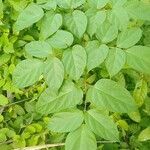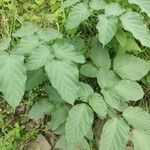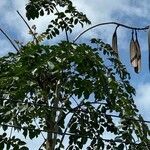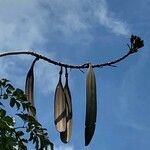| Therapeutic use
|
Diuretics (bark), Abdominal pain (bark), Abortifacient agents (bark), Analgesics (bark), Anemia (bark), Anthelmintics (bark), Anti-bacterial agents (bark), Anticonvulsants (bark), Antihypertensive agents (bark), Anti-infective agents (bark), Anti-infective agents, local (bark), Anti-inflammatory agents (bark), Antineoplastic agents (bark), Antioxidants (bark), Antipyretics (bark), Antirheumatic agents (bark), Antitussive agents (bark), Appetite stimulants (bark), Arthralgia (bark), Arthritis (bark), Asthma (bark), Bronchitis (bark), Burns (bark), Cardiovascular diseases (bark), Chickenpox (bark), Demulcents (bark), Diabetes mellitus (bark), Diarrhea (bark), Digestive system diseases (bark), Dyspepsia (bark), Foodborne diseases (bark), Fractures, bone (bark), Furunculosis (bark), Gastrointestinal diseases (bark), Hemorrhoids (bark), Herpes simplex (bark), Immunomodulation (bark), Infertility (bark), Inflammation (bark), Jaundice (bark), Leprosy (bark), Leukorrhea (bark), Liver diseases (bark), Malaria (bark), Measles (bark), Menorrhagia (bark), Menstruation disturbances (bark), Mumps (bark), Neurotic disorders (bark), Paralysis (bark), Parasympatholytics (bark), Periodontitis (bark), Pneumonia (bark), Polyuria (bark), Postnatal care (bark), General tonic for rejuvenation (bark), Skin ulcer (bark), Smallpox (bark), Snake bites (bark), Sprains and strains (bark), Ulcer (bark), Urinary tract infections (bark), Vitiligo (bark), Wound healing (bark), Disorder of prostate (bark), Diaphoretic (bark), Dyspepsia (flower), Flatulence (flower), Jaundice (flower), Parasympatholytics (flower), Rabies (flower), Ulcer (flower), Analgesics (fruit), Anthelmintics (fruit), Antihypertensive agents (fruit), Antioxidants (fruit), Antipyretics (fruit), Antitussive agents (fruit), Appetite stimulants (fruit), Astringents (fruit), Bronchitis (fruit), Cardiovascular diseases (fruit), Cathartics (fruit), Cholera (fruit), Colic (fruit), Cough (fruit), Dental caries (fruit), Diabetes mellitus (fruit), Diarrhea (fruit), Digestive system diseases (fruit), Dysentery, amebic (fruit), Dyspepsia (fruit), Expectorants (fruit), Flatulence (fruit), Gastrointestinal diseases (fruit), Helminthiasis (fruit), Hemorrhage (fruit), Hemorrhoids (fruit), Jaundice (fruit), Malaria (fruit), Pain (fruit), Parasympatholytics (fruit), Pharyngitis (fruit), Pregnancy complications (fruit), Snake bites (fruit), Stomach diseases (fruit), Ulcer (fruit), Vitiligo (fruit), Abdominal pain (leaf), Analgesics (leaf), Anticonvulsants (leaf), Antihypertensive agents (leaf), Anti-inflammatory agents (leaf), Antineoplastic agents (leaf), Antioxidants (leaf), Antipyretics (leaf), Antirheumatic agents (leaf), Antitussive agents (leaf), Appetite stimulants (leaf), Arthralgia (leaf), Diabetes mellitus (leaf), Diarrhea (leaf), Dyspepsia (leaf), Emollients (leaf), Flatulence (leaf), Gastrointestinal diseases (leaf), Headache (leaf), Inflammation (leaf), Jaundice (leaf), Leprosy (leaf), Liver diseases (leaf), Malaria (leaf), Measles (leaf), Parasympatholytics (leaf), Periodontitis (leaf), Rabies (leaf), General tonic for rejuvenation (leaf), Splenomegaly (leaf), Sprains and strains (leaf), Ulcer (leaf), Wounds and injuries (leaf), Jaundice (rhizome), Abdominal neoplasms (root), Abdominal pain (root), Abortifacient agents (root), Analgesics (root), Anorexia (root), Anthelmintics (root), Anti-bacterial agents (root), Antidotes (root), Antiemetics (root), Antifungal agents (root), Anti-inflammatory agents (root), Antineoplastic agents (root), Antioxidants (root), Antipyretics (root), Antirheumatic agents (root), Antitubercular agents (root), Aphrodisiacs (root), Appetite stimulants (root), Arthritis (root), Asthma (root), Astringents (root), Biliary tract diseases (root), Bronchitis (root), Cathartics (root), Colic (root), Cough (root), Demulcents (root), Diabetes mellitus (root), Diarrhea (root), Digestive system diseases (root), Diuretics (root), Dysentery (root), Dysentery, amebic (root), Dyspepsia (root), Ear diseases (root), Edema (root), Expectorants (root), Fertility agents (root), Fever (root), Flatulence (root), Galactogogues (root), Gout (root), Helminthiasis (root), Hemorrhoids (root), Hiccup (root), Hypohidrosis (root), Immunomodulation (root), Infertility (root), Inflammation (root), Jaundice (root), Kidney diseases (root), Laxatives (root), Leprosy (root), Lipid peroxidation (root), Liver diseases (root), Menstruation disturbances (root), Neuralgia (root), Parasympatholytics (root), Postnatal care (root), Pregnancy complications (root), General tonic for rejuvenation (root), Respiratory tract diseases (root), Skin diseases (root), Smallpox (root), Snake bites (root), Sprains and strains (root), Thirst (root), Ulcer (root), Urinary tract infections (root), Urination disorders (root), Urologic diseases (root), Vitiligo (root), Vomiting (root), Wound healing (root), Wounds and injuries (root), Otorrhea (root), Diaphoretic (root), Rheumatoid arthritis (root), Analgesics (seed), Anemia (seed), Anthelmintics (seed), Anticonvulsants (seed), Antipyretics (seed), Antirheumatic agents (seed), Antitussive agents (seed), Arthralgia (seed), Asthma (seed), Bronchitis (seed), Cardiovascular diseases (seed), Cathartics (seed), Diabetes mellitus (seed), Diarrhea (seed), Digestive system diseases (seed), Dysmenorrhea (seed), Ear diseases (seed), Fertility agents (seed), Foodborne diseases (seed), Furunculosis (seed), Hemorrhoids (seed), Infertility (seed), Inflammation (seed), Jaundice (seed), Leukorrhea (seed), Menorrhagia (seed), Menstruation disturbances (seed), Mumps (seed), Parasympatholytics (seed), Pharyngitis (seed), Pneumonia (seed), Postnatal care (seed), Scorpion stings (seed), Skin ulcer (seed), Snake bites (seed), Tonsillitis (seed), Ulcer (seed), Urinary tract infections (seed), Urination disorders (seed), Wound healing (seed), Dyspepsia (shoot), Flatulence (shoot), Jaundice (shoot), Rabies (shoot), Antioxidants (stem), Antirheumatic agents (stem), Scorpion stings (stem), Headache (unspecified), Ache(Stomach) (unspecified), Anthrax (unspecified), Antiseptic (unspecified), Astringent (unspecified), Bite(Snake) (unspecified), Cholera (unspecified), Diaphoretic (unspecified), Diarrhea (unspecified), Dysentery (unspecified), Dyslactation (unspecified), Dyspepsia (unspecified), Dysuria (unspecified), Enterosis (unspecified), Fever (unspecified), Otorrhea (unspecified), Parturition (unspecified), Pimple (unspecified), Rheumatism (unspecified), Sore (unspecified), Splenomegaly (unspecified), Stomachic (unspecified), Swelling (unspecified), Tonic (unspecified), Tonsillitis (unspecified), Toothache (unspecified), Tumor(Abdomen) (unspecified), Vermicide (unspecified), Vertigo (unspecified), Wound(Veterinary) (unspecified), Colic (unspecified), Epilepsy (unspecified), Stomach (unspecified), Gastrosis (unspecified), Puerperium (unspecified), Purgative (unspecified), Rinderpest (unspecified), Urticaria (unspecified), Diuretic (unspecified), Acne vulgaris (unspecified), Analgesics (unspecified), Anemia (unspecified), Anorexia (unspecified), Anticonvulsants (unspecified), Antihypertensive agents (unspecified), Anti-obesity agents (unspecified), Antipyretics (unspecified), Antirheumatic agents (unspecified), Arthritis (unspecified), Astringents (unspecified), Bronchitis (unspecified), Cathartics (unspecified), Diabetes mellitus (unspecified), Digestive system diseases (unspecified), Edema (unspecified), Flatulence (unspecified), Hypersensitivity (unspecified), Jaundice (unspecified), Mental disorders (unspecified), Paralysis (unspecified), Parasympatholytics (unspecified), Postnatal care (unspecified), General tonic for rejuvenation (unspecified), Respiratory tract diseases (unspecified), Skin ulcer (unspecified), Smallpox (unspecified), Snake bites (unspecified), Splenic diseases (unspecified), Urination disorders (unspecified)
|




